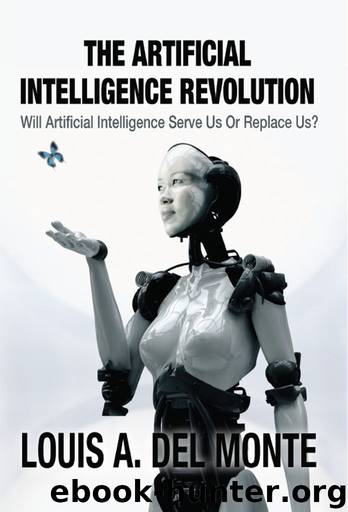The Artificial Intelligence Revolution: Will Artificial Intelligence Serve Us Or Replace Us? by Louis Del Monte

Author:Louis Del Monte [Del Monte, Louis]
Language: eng
Format: azw3
Published: 2014-04-29T16:00:00+00:00
Soft: from software-based simulation
Hard: from hardware-based simulations
Wet: from biochemistry simulations
For our purposes, I will focus only on the first two, since they apply to artificial intelligence as we commonly discuss it today. The category of “wet,” however, someday also may apply to artificial intelligence—if, for example, science is able to grow biological neural networks in the laboratory. In fact there is an entire scientific field known as synthetic biology, which combines biology and engineering to design and construct biological devices and systems for useful purposes. Synthetic biology currently is not being incorporated into AI simulations and is not likely to play a significant role in AI emulating a human brain. As synthetic biology and AI mature, however, they may eventually form a symbiotic relationship.
No current definition of life considers any A-life simulations to be alive in the traditional sense (i.e., constituting a part of the evolutionary process of any ecosystem). That view of life, however, is beginning to change as artificial intelligence comes closer to emulating a human brain. For example Hungarian-born American mathematician John von Neumann (1903–1957) asserted that “life is a process which can be abstracted away from any particular medium.” In particular this suggests that strong AI (artificial intelligence that completely emulates a human brain) could be considered a life-form, namely A-life.
This is not a new assertion. In the early 1990s, ecologist Thomas S. Ray asserted that his Tierra project (a computer simulation of artificial life) did not simulate life in a computer but synthesized it. This begs the following question: How do we define A-life?
The earliest description of A-life that comes close to a definition emerged from an official conference announcement in 1987 by Christopher Langton that was published subsequently in the 1989 book Artificial Life: The Proceedings of an Interdisciplinary Workshop on the Synthesis and Simulation of Living Systems.
Artificial life is the study of artificial systems that exhibit behavior characteristic of natural living systems. It is the quest to explain life in any of its possible manifestations, without restriction to the particular examples that have evolved on earth. This includes biological and chemical experiments, computer simulations, and purely theoretical endeavors. Processes occurring on molecular, social, and evolutionary scales are subject to investigation. The ultimate goal is to extract the logical form of living systems.
Kurzweil predicts that intelligent machines will have equal legal status with humans by 2099. As stated previously, his batting average regarding these types of predictions is about 94 percent. Therefore it is reasonable to believe that intelligent machines that emulate and exceed human intelligence eventually will be considered a life-form. In this and later chapters, however, I discuss the potential threats this poses to humankind. For example what will this mean in regard to the relationship between humans and intelligent machines? This question relates to the broader issue of the ethics of technology, which is typically divided into two categories.
Roboethics: This category focuses on the moral behavior of humans as they design, construct, use, and treat artificially intelligent beings.
Machine ethics: This category focuses on the moral behavior of artificial moral agents (AMAs).
Download
This site does not store any files on its server. We only index and link to content provided by other sites. Please contact the content providers to delete copyright contents if any and email us, we'll remove relevant links or contents immediately.
Enlightenment Now: The Case for Reason, Science, Humanism, and Progress by Steven Pinker(7228)
A Journey Through Charms and Defence Against the Dark Arts (Harry Potter: A Journey Through…) by Pottermore Publishing(4781)
The Immortal Life of Henrietta Lacks by Rebecca Skloot(4525)
A Journey Through Divination and Astronomy by Publishing Pottermore(4344)
Elon Musk by Ashlee Vance(4028)
Origin Story: A Big History of Everything by David Christian(3648)
COSMOS by Carl Sagan(3554)
Alchemy and Alchemists by C. J. S. Thompson(3449)
Bad Pharma by Ben Goldacre(3355)
Enlightenment Now by Steven Pinker(3335)
Shadow of Night by Deborah Harkness(3302)
Inferior by Angela Saini(3276)
A Mind For Numbers: How to Excel at Math and Science (Even If You Flunked Algebra) by Barbara Oakley(3217)
Origin Story by David Christian(3147)
The Code Book by Simon Singh(3074)
Signature in the Cell: DNA and the Evidence for Intelligent Design by Stephen C. Meyer(3071)
The Elements by Theodore Gray(2998)
A Brief History of Time by Stephen Hawking(2960)
A Journey Through Potions and Herbology (A Journey Through…) by Pottermore Publishing(2826)
